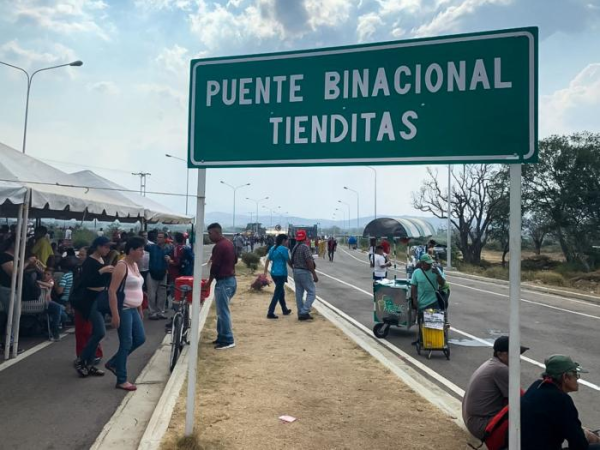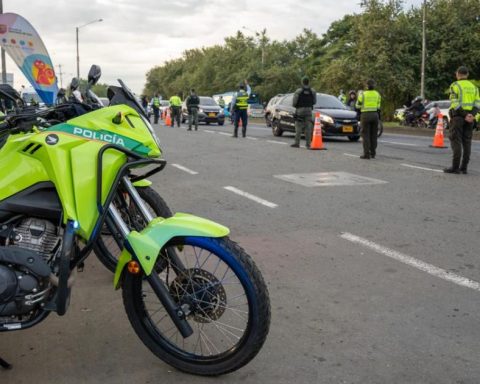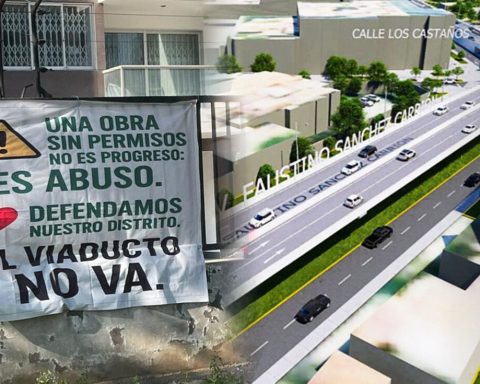Colombia and Venezuela will reopen this Sunday, January 1, 2023 the entrance to the Atanasio Girardot international bridge, also known as ‘Shops Bridge’.
This infrastructure, which unites the municipalities of Villa del Rosario in Norte de Santander (Colombia) with Pedro Maria Urena in Táchira State (Venezuela), construction began in 2014 and was conceived from the outset to ease transport congestion at the binational border, one of the busiest on the continent.
(See: What comes after the end of the ‘interim government’ of Guaidó in Venezuela).
The Atanasio Girardot International Bridge It will be enabled as of this Sunday, and will allow the permanent passage of international cargo and passenger transport.
The protocols and conditions To facilitate the operation and the passage through this border point, the technical teams of the ministries of External relationships; Trade, Industry and Tourism and Transport, in the Colombian part, with their Venezuelan counterparts.
The foreign ministerÁlvaro Leyva Durán, pointed out that with the start-up of this infrastructure “The commitments of the governments of Colombia and Venezuela and the desire of Presidents Gustavo Petro and Nicolás Maduro to advance in the normalization of our relations materialize. This is work that will allow us to guarantee peace and security on our border and will directly benefit our peoples.”
At the same time, the Minister of Commerce, Industry and TourismGermán Umaña Mendoza, stressed that “Beyond the numbers, what we are looking for is a real integration as we already had it in the past. This is the government of social humanism, the government of recovering the paths of development, of sustainability, and, above all, of working to reduce the inequality gap in our countries and our borders. Greater integration between Colombia and Venezuela allows us to promote productive chains, generate greater added value and advance in industrial complementarity”.
The official stressed that the government has been restoring border crossings since last September 26 with the opening of the Simón Bolívar and Francisco de Paula Santander along the border with Norte de Santander, and now, with the operation of the Atanasio Girardot bridgesince the beginning of 2023 and all the crossings are fully enabled, including those of Arauca, Puerto Santander and the river crossings.
(See: Venezuelan Bolívar Wobbles Again: What Makes It So Unstable?).
For his part, the Minister of Transportation, Guillermo Reyes González, assured that after several months of work “We have decided, together with the Government of Venezuela, to put into operation the Tienditas international bridge that is now renamed Atanasio Girardot, in homage to one of the great heroes of independence.”
with this decisionadded“we completely reopened the border between our countries, in order to guarantee the mobility of cargo and passengers and to promote trade and tourism in Colombia and Venezuela, not only by land, but also by air and river” .
In Arauca, La Guajira, Norte de Santander and in all the departments with which Colombia borders Venezuela, the crossings are reactivated, some of which had been paralyzed more than 7 years.
“In the Government of Change we will continue working hand in hand with the mayors and governors to fight against illegality, smuggling and continue to recover the brotherhood of two towns that will improve their quality of life with this border reopening,” added Minister Reyes González.
The Atanasio Girardot bridge It is located about 20 minutes from the center of Cúcuta, in the Villa Silvania sector, in the Eastern Road Ring, and about 10 kilometres north of the Simón International Bridge (Cúcuta-Colombia).
It crosses the Táchira river, and has six lanes for the vehicles move in both directions.
Colombian-Venezuelan border.
Andres Carvajal
HOW WILL THE TRANSIT ACROSS THE BORDER BRIDGE OPERATE?
The technical teams of the two countries, which include the Ministries of Foreign Affairs on the Colombian side; Commerce, Industry and Tourism and Transport, and entities such as Colombian Migration and DIAN, among others, have already defined the requirements and conditions that must be met by both vehicles as drivers who want to travel through this new infrastructure and through the other bridges that unite the two countries.
In the case of private vehicles Venezuelans Those who want to enter Colombian territory must prove the property title or document from the Venezuelan authority that proves the property; the SOAT or equivalent insurance policy, with the same protection and coverage characteristics; the identification plates of the country of origin and be in optimal mechanical and safety conditions.
Yes the vehicle entered for a period equal to or greater than three months, must have a technical-mechanical review.
(See: Aerolínea Estelar does not have permission to fly from Venezuela to Colombia).
Their drivers will be required to have a driving license authorized by the competent authority; as well as the passport of the Bolivarian Republic of Venezuela or Venezuelan identity card, or Special Permit of Permanence (PEP), o Temporary Protection Permit (PPT), o Border Mobility Card (TMF) or another, as required by the immigration authority.
So that Colombian vehicles can enter Venezuelathe authorities of the neighboring country will require a property document issued by the competent authority in the name of the driver; insurance policy civil liability that has coverage in Venezuelan territory; Identification plates of the country of origin and optimal mechanical and safety conditions.
Colombian drivers will be required to have a license issued by the competent authority and the identity document or passport issued by Colombian authorities.
In the case of cargo transport vehicles, in addition to the policies and certificates of optimal mechanical and safety conditions, the border authority will require the certificate or suitability document granted to the company and permit to provide services or complementary permit to provide services for cargo.
If it’s about passenger transportthe original permit for the provision of passenger services and the complementary permit for the provision of passenger services will be required, as well as the rest of the sanitary characterimmigration and customs required by the competent authorities.

Border with Venezuela.
EFE
Good time for integration
In addition to sharing more than 2,200 kilometers of border, Colombia and Venezuela they have historically been great allies in political, social and commercial matters.
In this last aspect, between January and October trade between the two countries, that is, imports plus exports, reached $582.6 million, an increase of 89.9% compared to the same period of 2021.
From this, the exports of total goods from Colombia to Venezuela reached US$512.9 million, an increase of 102.5% compared to the same period in 2021.
Imports reached US$69.7 million, an increase of 30.5%. In 2021, trade between the two countries (exports plus imports) closed at US$394 million.
(See: Venezuela, the ‘only Latin American country with armed drones’).
Of that, the exports were US$331.2 million and imports $62.6 million.
The Minister of Commerce, German Umana Mendozacalculates that this year, with the safe and concerted opening, “We could be in the order of US$800 million, a very representative figure. Next year, depending on the expected recovery of the economy in the two countries, we could reach trade between US$1.700 and US$1.800 million. And at the end of the government of President Petro we hope to reach a trade between US$4,000 and US$5,000 million”.
In the good results of this year the reopening for the passage of cargo through the bridges has an impact Simon Bolivar and Francisco de Paula Santanderwhich materialized since last September 26.
From that date and up to December 291,204 trucks with export and import merchandise have passed through the two bridges.
This has represented a trade (for those two bridges alone) of US$26.6 million and 27,269 tons of export and import cargo.
BRIEFCASE

















